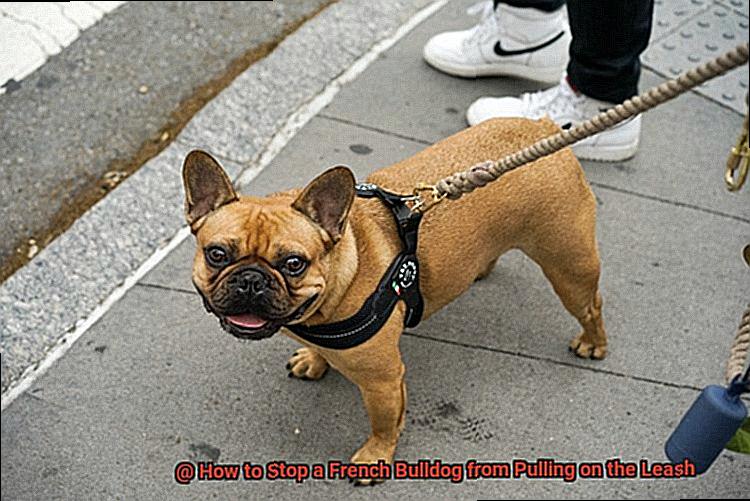How to Stop a French Bulldog from Pulling on the Leash?
Are you tired of your French Bulldog constantly pulling on the leash during walks?
It can be frustrating and even dangerous for both you and your furry friend. But don’t worry, we’ve got you covered with some practical tips to help stop this behavior.
French Bulldogs are known for their playful personalities and eagerness to please, but they can also be stubborn when it comes to walking on a leash. This can lead to them draining their owner’s resources and potentially injuring themselves or their human companion.
So, what’s the solution? In this blog post, we’ll explore positive reinforcement strategies that encourage good behavior and show your French Bulldog how to lead rather than follow.
We’ll also discuss different harness options that may suit your pup’s needs, as well as some of the best leash-training techniques to make walks enjoyable for everyone involved. By the end of this article, you’ll have the knowledge and skills necessary to teach your French Bulldog how to walk politely on a leash.
No more pulling or frustration. With these tips, you’ll have a happy, well-behaved dog who loves going for walks with you.
Let’s get started.

Why French Bulldogs Pull on the Leash
Contents
Well, one reason is due to their natural instincts. Frenchies are active dogs with a strong prey drive and a curious nature, which can cause them to pull if they see something interesting or exciting.
This is why it’s important to train your Frenchie to walk politely on a leash from an early age. Another reason why French Bulldogs may pull on the leash is because of improper training.
If your Frenchie hasn’t been taught how to behave while on a leash, they may not understand that pulling is not acceptable behavior. It’s important to use positive reinforcement training and reward them for good behavior, rather than punishing them for pulling.
Lastly, discomfort or pain can also cause French Bulldogs to pull on the leash. If your Frenchie is wearing an uncomfortable harness or collar, or if they’re experiencing any pain or discomfort, they may pull on the leash in an attempt to alleviate their discomfort.
This is why it’s important to choose the right equipment for your Frenchie, such as a comfortable harness that distributes pressure evenly across their chest. To prevent your Frenchie from pulling on the leash, start by teaching them basic commands such as “sit” and “stay.”
Make sure your dog is calm and relaxed before putting them on the leash and starting your walk. If they start pulling, stop walking immediately and wait for them to calm down before starting again.
Remember to use positive reinforcement training by rewarding good behavior with treats or praise. In conclusion, understanding why French Bulldogs pull on the leash is crucial in addressing this behavior.
The Right Equipment for Walking a Frenchie
Walking your French Bulldog can be a delightful experience for you and your furry companion, but it can also be a daunting task if your Frenchie pulls on the leash.
That’s why selecting the proper equipment is crucial to ensure a safe and comfortable walk. To begin with, a well-fitting harness is of utmost importance for your Frenchie’s health and safety.
Unlike collars that can put pressure on their delicate necks and lead to potential health issues, harnesses distribute the load evenly across their body, making them a healthier alternative.

A front-clip harness is an excellent option for Frenchies as it redirects their attention and prevents them from pulling while a back-clip harness is perfect for well-trained dogs who don’t have the tendency to pull.
A shorter leash also provides you with more control over your Frenchie’s movements and keeps them from wandering off or getting too far ahead of you. A leash that is around four to six feet in length is ideal for walking a Frenchie.
Selecting healthy treats and safe toys for your furry friend is essential, and always supervise them while they play.
Setting Clear Rules and Boundaries
Walking your French Bulldog should be an enjoyable bonding experience, but it can quickly turn into a frustrating ordeal if your furry friend is pulling on the leash.
To avoid this, setting clear rules and boundaries is essential. Dogs thrive on structure and routine, so establishing a consistent walking routine is crucial.
Choose a specific time of day for walks and stick to it. This helps your French Bulldog understand when it’s time for exercise and when it’s time to relax.
Also, use a clear signal or command that indicates the start of a walk, like grabbing the leash or saying “let’s go.” Being the leader of the pack is another important aspect of setting clear rules and boundaries.
Your French Bulldog must know that you’re in charge and they should follow your example. Always walk ahead of your dog, and avoid allowing them to pull you in different directions.
Consistency is the key to successful rule-setting. If you allow your French Bulldog to pull on the leash one day but not the next, they’ll be confused about what behavior is acceptable.
Ensure that everyone involved in walking your dog knows the rules and follows them consistently. Setting clear rules and boundaries takes patience, perseverance, and consistency.
Positive Reinforcement Training
If you’re tired of your furry friend constantly pulling on the leash, positive reinforcement training is a fun and effective way to teach your French Bulldog to walk calmly beside you.
Positive reinforcement training involves rewarding your dog’s good behavior with treats, praise, or other positive stimuli, while ignoring bad behavior. To start positive reinforcement training, choose a treat that your French Bulldog loves and can easily eat while walking.
You can also use verbal praise or petting as a reward. It’s important to reward your dog immediately after they exhibit good behavior, such as walking calmly beside you without pulling on the leash.
One helpful tool for positive reinforcement training is a clicker. This small device makes a distinct clicking sound when pressed and can be used to mark desired behavior when your dog walks calmly on the leash.
For instance, when your French Bulldog walks alongside you without pulling, click the device and then reward them with a treat or praise. Consistency is key when it comes to positive reinforcement training.
It’s essential to consistently reward good behavior and ignore bad behavior for this method to be effective. If your French Bulldog pulls on the leash, stop walking immediately and wait until they calm down before continuing.
Do not reward your dog for pulling or dragging you along on the leash. With patience and perseverance, positive reinforcement training can be an incredibly effective way to train your French Bulldog to walk politely on a leash.
Consistency is Key
The solution lies in one word: consistency.
When it comes to teaching your French Bulldog to stop pulling on the leash, consistency is key. You need to be consistent in your approach and training techniques every time you take your Frenchie for a walk.
Think of it like baking a cake – if you don’t follow the recipe and use the same ingredients every time, the result will be different each time. To avoid any confusion or mixed signals, make sure all members of your household are using the same methods and commands.
This will help your Frenchie understand what is expected of them during their walks. Stick to a regular walking routine, walking your Frenchie at the same time every day and using the same route if possible.
This will reinforce good behavior and make your furry friend an enjoyable walking companion. Patience is key when it comes to consistency.
It may take several weeks or even months for your Frenchie to fully understand what you want them to do. But with patience and consistency, you will eventually see results.
Another important aspect of consistency is rewarding good behavior and correcting bad behavior every time. When your Frenchie walks calmly on the leash without pulling, praise and reward them with treats or verbal praise.
If they start pulling, immediately stop walking and give a firm but gentle correction before continuing. In conclusion, consistency is vital when it comes to training your French Bulldog to stop pulling on the leash.
Common Mistakes to Avoid When Training Your French Bulldog
Training your French Bulldog to walk on a leash is crucial to their physical and mental health, but it can be challenging.
However, by avoiding common mistakes, you can make the process more manageable and enjoyable for both you and your pup. One of the most common mistakes is using the wrong leash.
Retractable leashes may seem convenient, but they can be hazardous and encourage pulling. Opt for a standard 6-foot leash made of nylon or leather instead.
It will give you better control and allow you to focus your dog’s attention on you. Consistency is key when it comes to training your furry friend.
Set aside time each day for training and be consistent with your commands. Dogs learn best through repetition, so inconsistency can confuse them and hinder their progress.
Pulling on the leash can cause discomfort and anxiety for your French Bulldog. Instead of pulling, use positive reinforcement techniques such as treats and praise to reinforce good behavior.
Punishing your dog for pulling is not only ineffective but can also lead to fear and anxiety in your pup. In conclusion, training your French Bulldog to walk on a leash requires patience, consistency, and positivity.
TOU46FgZ9lM” >
Conclusion
In conclusion, mastering the art of leash training your French Bulldog requires a combination of patience, persistence, and optimism.
Understanding why your Frenchie is pulling on the leash is crucial in addressing this behavior. It could be due to their natural instincts, inadequate preparation, or discomfort caused by ill-fitting equipment.
To ensure a safe and comfortable walk for both you and your furry friend, it’s essential to choose the right gear. A well-fitting harness and a shorter leash will provide you with more control over your dog’s movements and prevent them from wandering off or getting too far ahead of you.
Establishing clear rules and boundaries during walks can also help avoid frustration. Dogs thrive on structure and routine, so creating a consistent walking schedule with specific times of day helps them understand when it’s time for exercise and when it’s time to relax.
Positive reinforcement training is an effective way to teach your French Bulldog to walk calmly alongside you. Consistency is key when rewarding good behavior and discouraging inappropriate conduct.
Lastly, avoiding common mistakes such as using the wrong leash or punishing your dog will create a positive learning environment that benefits both you and your furry companion.




